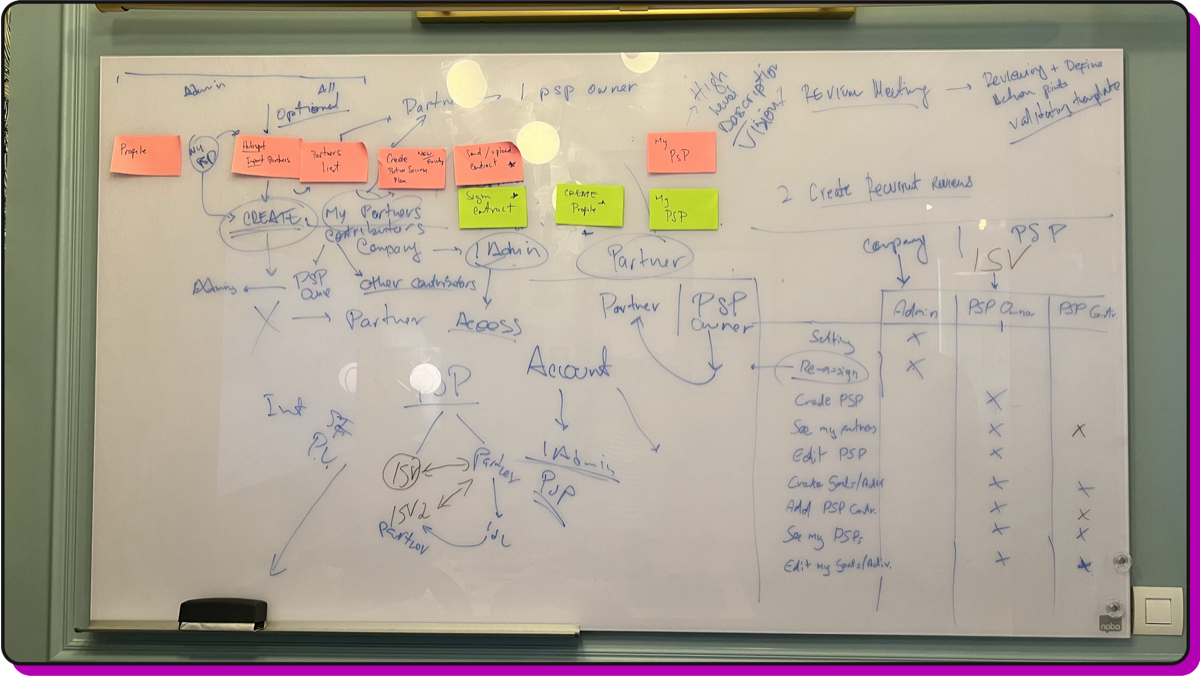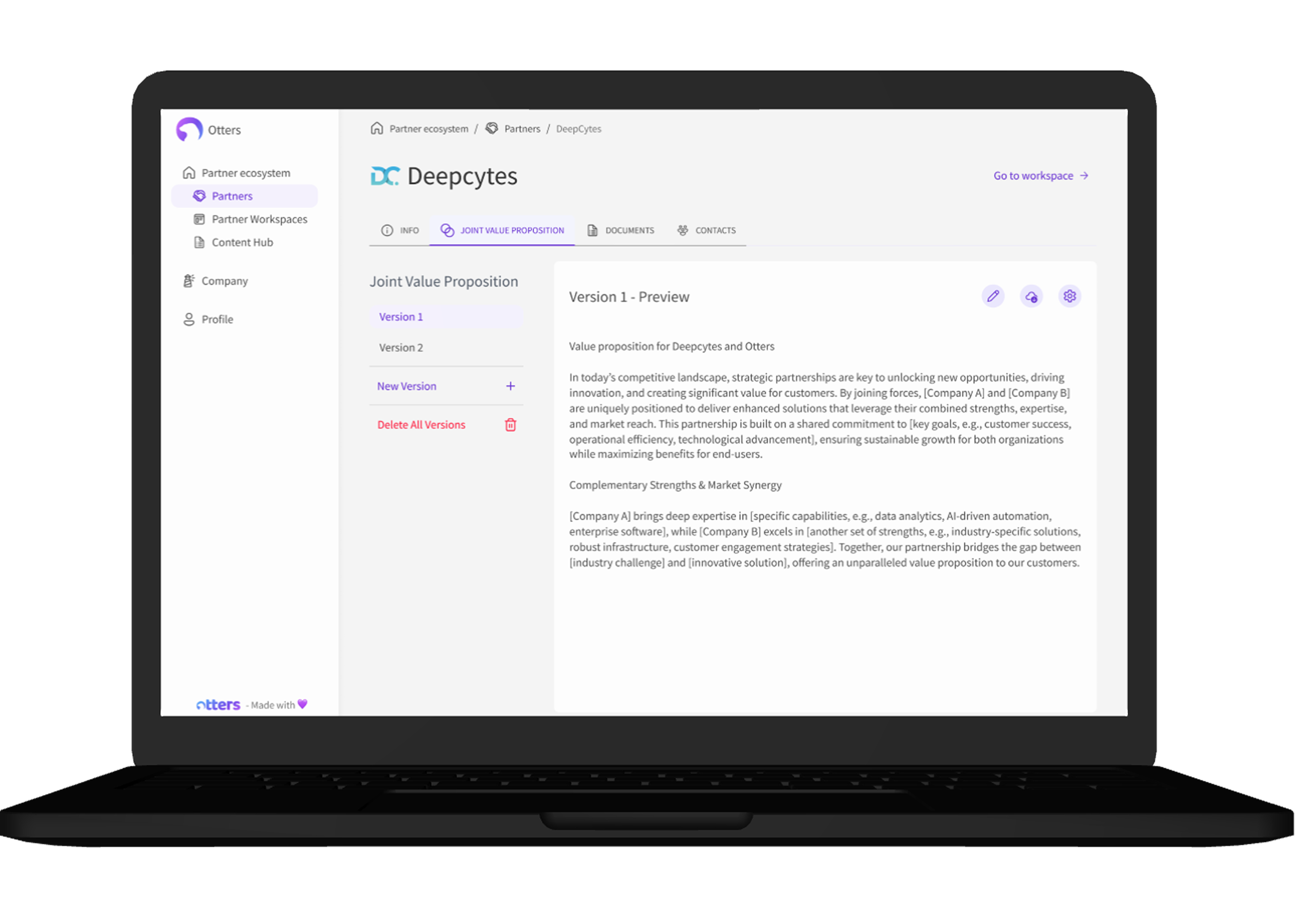
AI transformation in a B2B SaaS
Transforming a manual workflow into an efficient AI-driven process
SaaS
B2B
AI
Digital transformation

Otters is a B2B AI-powered partnership management platform that helps companies streamline their partner ecosystem, automate workflows, and scale partner relationships through intelligent insights and automation.
This project delivered an end-to-end AI-powered solution to automate manual reporting tasks for partnership managers, streamlining the process from discovery through delivery.
Traditional partnership workflows are slow and affect business growth
When reaching out to potential partners, crafting a compelling and tailored Joint Value Proposition (JVP) is crucial.
This process typically requires around four hours of effort, creating a major bottleneck for partnership managers. As a result, they're limited in how many potential partners they can engage with, reducing the chances of finding the best fit.
Feature discovery
During our interviews with users, we discovered that they were spending a significant amount of time on manual tasks, such as crafting JVPs, collecting partner data, and manually tracking partner performance.
Understanding partnership management workflows
Through user interviews, workflow analysis, and data mining, I discovered that partnership managers were drowning in manual processes that could be automated with AI.

User interviews
Interviewed 13 VPs of partnerships, managers, and sales reps to understand their daily workflows, pain points, and automation needs.
Workflow mapping
Mapped current partnership management processes to identify automation opportunities and bottlenecks.
Data analysis
Analyzed existing platform usage data to understand feature feasibility.
AI capability audit
Evaluated current AI capabilities and identified opportunities for intelligent automation and insights.
AI-powered JVPs will increase Revenue
By leveraging AI to automate the creation of Joint Value Propositions, we can significantly reduce manual work while improving partnership outcomes and user satisfaction.
This will allow partnership managers to engage with more potential partners, increasing the chances of finding the best fit and ultimately increasing revenue.
Automate the mundane
Use AI to handle data entry and partner research, freeing up managers to focus on strategic relationship building with more partners.
Provide intelligent insights
Leverage AI to analyze partnership data and provide actionable recommendations for optimizing partner relationships and revenue.
Validation
Lean prototyping: using the concierge model for early validation
Before building the feature, I created GPT designed to generate a Joint Value Proposition (JVP) based on key user inputs:
- Company Ideal Partner Profile
- Partner’s website
- Customer pain points
- Potential value delivered
- Previous JVP example
The output was a ready-to-use JVP, tailored for sharing with potential partners.
8/9 users rated the quality of the JVPs as equal or better than before
Validation - Phase 1
We used the GPT to generate Joint Value Propositions (JVPs) by combining customer-provided data from Otters with publicly sourced information about potential partners. The resulting JVPs were shared with customers to gather feedback and ensure alignment.
Validation - Phase 2
We made the GPT available to Otters users, incorporating their ongoing feedback to improve its outcome and how delivered value. This would ultimately lead to a more accurate and effective JVP generation process.
Implementation
Improved partner outreach process
Identifying a Potential Partner
After finding a potential partner, the user adds them to the partner acquisition pipeline, entering key details such as their website.
Creating a Joint Value Proposition
The partnership manager creates a JVP, which the AI generates using customer and partner information combined with publicly available data. At this point, they can edit it or create different versions to ensure it's tailored to the partner's needs.
Reaching out to the potential partner
With the JVP in hand, the partnership manager evaluates fit and approaches the partner with a clear, compelling proposal.
AI-powered JVP generation
Intelligent JVP Generation
AI analyzes partner websites, company profiles, and customer data to automatically generate compelling Joint Value Propositions tailored to each potential partner.
Smart Data Integration
Automatically combines customer-provided data from Otters with publicly sourced information about potential partners to create comprehensive JVPs.
Quality Validation
Built-in quality checks ensure generated JVPs meet professional standards, with 8/9 users rating them equal or better than manually created versions.
Iterative Improvement
Continuous learning from user feedback and edits to improve JVP quality and relevance over time, ensuring better partnership outcomes.
Product Led Growth
By helping customers create high-quality JVPs faster, Otters.ai enabled them to scale partnerships and grow their businesses — driving higher revenue per customer as partner volume increased.

Faster completion
Time to create a JVP reduced from ~4 hours to just 30 minutes, reporting a 3x increase in the manager's ability to reach out to potential partners.
Pipeline expansion
Customers expanded their partnership pipeline, engaging with more potential partners in less time.
High feature adoption
88% of users adopted the feature and rated the quality of their JVPs as equal to or better than before.
Higher revenue
Otters’ RPC grew 17%* as customers onboarded more partners, consistent with its partnership-driven business model.
Key insights from building AI-powered features
Start with the concierge model
Before building complex AI features, validate the concept using manual processes or simple tools like GPT. This approach helped us prove value and gather user feedback before significant development investment.
Quality over speed matters
While AI can dramatically reduce time (4 hours → 30 minutes), users prioritize quality. 8/9 users rated AI-generated JVPs as equal or better than manual versions, proving that automation can maintain or improve output quality.
User feedback drives iteration
Continuous user feedback and editing behavior provided valuable data to improve the AI model. The iterative approach of Phase 2 validation was crucial for achieving 88% feature adoption and 17% revenue growth.

